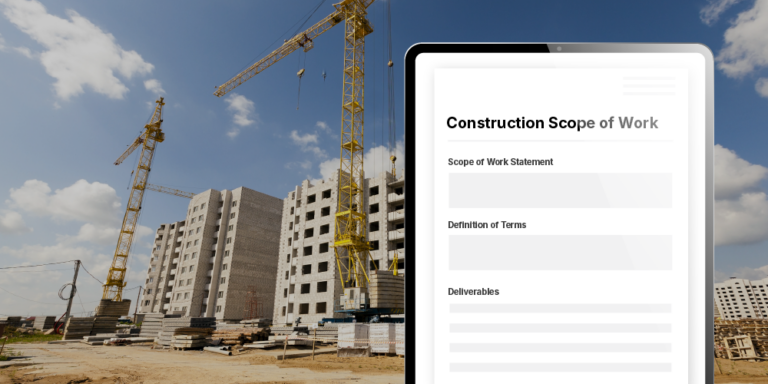— 7 min read
Writing an Effective Construction Scope of Work
Last Updated Sep 5, 2024
Last Updated Sep 5, 2024

On any construction project, the scope of work outlines what needs to be completed to turn drawings and specifications on a page into a built environment. Through the scope of work, items of work get assigned to the appropriate parties and key details about those to-dos get communicated.
As a result, an effective construction scope of work is a cornerstone in a project’s success. And that puts pressure on the person or team tasked with writing this critical document.
Fortunately, a clear understanding of what’s required in a scope of work can ease the process exponentially, especially when paired with a template. Here, we look at the essential components for a construction scope of work and outline three steps to effectively draw one up.
Table of contents
What is a scope of work?
A construction scope of work — or SOW, for short — captures what needs to be completed to move a project from a concept in the owner’s mind to a tangible building. It outlines the goal of the project and extent of the work, from the tasks that will be tackled to the deadlines by which they should be completed.
Along with the construction drawings and specifications, the scope of work is a key component of the contract that lays out what needs to happen on the project and who’s responsible for that work. In fact, the SOW is so critical that it might dictate the type of contract that gets used. Without a detailed, well-defined construction scope of work, lump-sum contracts would be high-risk for all parties involved.
Since so much hinges on the scope of work for building construction, the person or team tasked with writing this guiding document needs to handle the drafting with care. This guide outlines some best practices to help create effective SOWs. It also includes a construction scope of work template tailored to the project size.
Who writes the scope of work?
SOWs vary depending on the project in question, but one thing is always true: the owner drives the construction scope of work. As the party behind the build, they’re the decision-maker on what the scope of work encompasses.
That said, the owner may not be the one to draft it, or even to ideate everything the SOW entails. Designers and engineers are often involved in creating the scope. Many owners bring in experts (e.g., consultants, a construction management firm, an owner’s representative) to write the construction scope of work.
Owner’s Scope of Work
At the owner level, the SOW tends to focus on the overall objectives and outcomes desired for the project — often developed in collaboration with design firms that help translate the owner's vision into feasible project goals.
When owners write a scope of work, it needs to be detailed enough so that contractors can appropriately bid for the job. If the Scope of work is unclear, contractor bids can be incomparable to one another, making bid leveling an impossible feat.
Contractor’s Scope of Work
On larger projects, an owner’s scope of work will traditionally focus on overall objectives. Because of this, contractors will often take on the responsibility of detailing out the specifics in a new scope of work.
In the same fashion that an owner writes a scope of work for contractors, a contractor will write an SOW for the subcontractors and specialty contractors, breaking down specific tasks, materials, and processes required.
Essential Components in a Construction Scope of Work
On any project, a SOW needs to contain enough detail that a contractor can accurately price and bid all of the work that’s required to complete the project. As one could imagine, the scope of work for a kitchen remodel will look completely different to the SOW of a new highway. Because of this, it’s difficult to say exactly what’s needed for each project’s SOW, but here are a few essential components that every SOW should include:
- A project overview (including goals for the project)
- Deliverables and milestones
- The proposed schedule
- The budget
- Technical details, like methods that should be used
- Administrative details like how the project management and coordination and any reporting processes
To encompass all of this, the scope of work might reference contract documents like the drawings and specifications.
Scope of Work: Real-World Examples
- San Diego Convention Center: Scope of work for the redesign of a central HVAC system
- Wyoming Department of Transportation: A scope of work for a highway construction project
3 Steps To Draft an Effective Scope of Work
An effective scope of work is one that is written clearly, providing enough detail about the project for all contractors to estimate and bid the project accurately. A well-structured SOW also simplifies bid leveling. Fortunately, owners don’t have to reinvent the wheel each time. A tried-and-true three-step process that leverages a construction scope of work template can help here.
1. Articulate the Vision
The first step in writing a clear and effective scope of work is having a solid understanding of the project itself. In other words, know what it is you want built.
Involving consultants, construction management teams, or general contractors (GCs) early on can jumpstart an idea into a clear, and realistic SOW. Early collaboration improves communication, clears up ambiguities, and uses structured frameworks like CSI divisions to guide the process. By bringing in experts early, owners can establish a solid foundation, reducing potential errors and ensuring smoother project execution.
2. Define the Project Requirements
Writing effective and detailed project requirements for a construction scope of work is essential for ensuring that all parties involved have a clear understanding of their responsibilities and the project’s objectives. The project requirements should include a list of the work required (often as broken down by CSI division) along with the details necessary to complete the work and the timeline and budget.
To ensure that the project requirements are thorough and clear enough for contractors to have a good understanding of the work, collaborate with consultants – such as a construction manager . Involving consultants will help confirm what work should be required for the project, the language and terminology that should be used, and the best way to organize the list of requirements.
3. Organize the Scope of Work
An effective scope of work should be easy to navigate. Organizing the SOW using Masterformat CSI divisions offers a structured way to break down complex projects into specific, manageable categories. Each division corresponds to a particular type of work, such as concrete, electrical, or HVAC, ensuring that no aspect of the project is overlooked.
By organizing the SOW according to CSI divisions, contractors and subcontractors can easily understand their responsibilities and the specific requirements of their tasks. This method not only clarifies what is included but also helps identify any scope gaps or overlaps in the scope, leading to a more comprehensive and accurate document.
Communicate through the SOW’s Evolution
It is not uncommon for a construction scope of work to evolve as the project progresses and more stakeholders get involved. This transformation often begins once the SOW is included in the bid package. When general contractors receive the SOW, they may ask questions to clarify details or fill in gaps. However, owners should be cautious, as some contractors might intentionally leave SOWs vague, hoping to capitalize on change orders. Therefore, it's crucial for owners not to rely too heavily on contractor feedback alone.
Given the potential for a SOW to undergo significant changes, it is essential to keep communication lines open to ensure that all parties have a clear understanding of the project. Effective collaboration helps refine the SOW and ensures all necessary details are included. The clearer everyone involved is about their tasks, the higher the likelihood of project success. Open communication and thorough understanding among all stakeholders are key to minimizing misunderstandings and achieving project goals efficiently.
Was this article helpful?
Thank you for your submission.
87%
13%
You voted that this article was . Was this a mistake? If so, change your vote here.
Scroll less, learn more about construction.
Subscribe to The Blueprint, Procore’s construction newsletter, to get content from industry experts delivered straight to your inbox.
By clicking this button, you agree to our Privacy Notice and Terms of Service.
Categories:
Tags:
Written by
Ben Ashburn
20 articles
Ben Ashburn is a Senior Construction Education Trainer at Procore. After a successful career as a construction estimator — working his way up from estimating manager to senior estimator — Ben has spent the most recent part of his career in construction sharing his skills with other as a construction educator. Ben has an extensive background in construction education: He has been an assistant professor in the Department of Construction Science at Texas A&M, and lectured about estimating, scheduling, management, and other related construction topics at Murray State University. He has been a construction training and learning development partner with Procore since 2019.
View profileKacie Goff
54 articles
Kacie Goff is a construction writer who grew up in a construction family — her dad owned a concrete company. Over the last decade, she’s blended that experience with her writing expertise to create content for the Construction Progress Coalition, Newsweek, CNET, and others. She founded and runs her own agency, Jot Content, from her home in Ventura, California.
View profileExplore more helpful resources

Tackling the Top 10 Construction Industry Issues
The construction industry is constantly evolving, bringing both opportunities and challenges. Companies must navigate an array of construction industry issues — from workforce shortages to integrating new technologies into their...

Mission Critical Construction: Strategies for Success
Mission critical construction involves building structures whose functions cannot afford to fail, as any disruptions can lead to significant consequences for society. Keeping data centers, hospitals, power plants and other...

Modular Construction and MEP: A Collaborative Pairing
In an age of supply chain disruptions, workforce shortages, and rising material costs, off-site construction — including modular construction methods and prefabricated materials — is surfacing as a multipurpose solution....

Connected Construction: Transforming the Industry Through Integration
Construction projects are becoming increasingly complex, so companies need to innovate to accurately and profitably complete these modern structures. Connected construction — using technology and data to improve communication, processes...